UPSC Daily Current Affairs- 10th September 2023 | Current Affairs & Hindu Analysis: Daily, Weekly & Monthly PDF Download
ADB Regional Conference and PM Gati Shakti
Subject: International Relations and Government Schemes

Why in News?
Recently, the 2023 Regional Cooperation and Integration (RCI) Conference was organised by the Asian Development Bank (ADB) at Tbilisi, Georgia where India showcased its PM Gatishakti National Master Plan.
What is the Asian Development Bank?
- About:
- ADB is a regional development bank established in 1966 with the objective of promoting social and economic development in Asia and the Pacific.
- It has 68 members; 49 are from within Asia and the Pacific and 19 outside. India is a founding member.
- ADB assists its members and partners by providing loans, technical assistance, grants, and equity investments to promote social and economic development.
- As of 31st December 2022, ADB's five largest shareholders are Japan and the US (each with 15.6% of total shares), China (6.4%), India (6.3%), and Australia (5.8%).
- It is headquartered in Manila, Philippines.
- About ADB Conference:
- Theme for 2023 Conference:
- Strengthening Regional Cooperation and Integration through Economic Corridor Development (ECD).
- Objective:
- Explore ways to integrate spatial transformation/area-centric approach with the ECD and strengthen regional cooperation through a broader approach.
- Knowledge sharing on application of the ECD framework and operational guidelines for investable projects.
- Participation:
- The conference saw participation from more than 30 member countries.
- India’s Role:
- At the RCI Conference, India offered its indigenously developed GIS-based technology though knowledge sharing to ADB and South Asia Subregional Economic Cooperation (SASEC) countries for enhancing socio-economic planning and regional cooperation.
- Theme for 2023 Conference:
What is PM GatiShakti National Master Plan for Multi-modal Connectivity?
- It is a Made in India initiative, a transformative ‘whole-of-government’ approach for integrated planning of multimodal infrastructure connectivity to economic nodes and social infrastructure, thereby improving logistics efficiency.
- PM Gati Shakti principles bring socio-economic area-based development as part of regional connectivity.
- PM GatiShakti was launched in October 2021.
- The Gati Shakti scheme subsumed Rs. 110 lakh crore National Infrastructure Pipeline launched in 2019.
- PM Gatishakti National Master Plan is a Geographic Information System (GIS) data-based digital platform with over 1400 data layers and 50+ tools.
- It provides visual representation of trunk and utility infrastructure, land use, existing structures, soil quality, habitation, tourism sites, forest sensitive areas etc.
- The initiative is also being implemented to enhance connectivity with regional partners as well. Some of the suitable examples are:
- The Indo-Nepal Haldia Access Controlled Corridor project (eastern Indian states and Nepal)
- Regional Waterways Grid (RWG) project for multimodal connectivity to growth centres and border points.
Source: The Hindu
“Bharat: The Mother of Democracy” Portal
Subject: International Relations
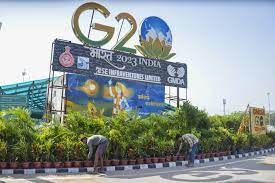
Why in News?
On the eve of the G20 leadership summit, the culture ministry on Friday launched a portal of the mega exhibition—‘Bharat: The Mother of Democracy’—to be held at Bharat Mandapam for global leaders attending the conference.
About “Bharat: The Mother of Democracy” Portal:
- The portal showcases the content on the history of democracy in India, showcasing 7,000 years of democratic ethos starting from the Sindhu-Saraswati civilisation to 2019.
- It is available in 16 languages, including German, French, Spanish, Arabic, Portuguese, Italian, Turkish, and Russian besides English and Hindi.
- The portal is divided into five sections and 22 sub-sections starting from Sindhu-Saraswati Civilisation (6000-2000BCE), Mahajanapada and Gantantra (7-8 BCE), Vijaynagar Empire (14-16 century), and Mughal emperor Akbar reign (1556-1605) to Constitution of India (1947) and Elections in Modern India (1952 onwards).
- Each section has a brief with images.
- The visitors can also download a brochure in the language of their choice.
- The catalogue also has the message of the Indian Prime Minister.
- The website-- www.motherofdemocracyg20.com-- is curated by the Indira Gandhi National Centre for the Arts (IGNCA).
Source: Times of India
Negotiations to Revive Black Sea Grain Deal
Subject: International Relations
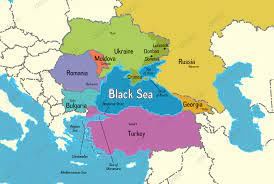
Why in News?
Recently, the Turkish President has met with the Russian President in order to revive Black Sea Grain Deal, which Russia had withdrawn from in July 2023.
What is the Black Sea Grain Initiative?
- About:
- The Black Sea Grain initiative endeavors to tackle escalating food prices emanating from supply chain disruptions because of Russian actions in the world’s ‘breadbasket’.
- The deal brokered by the United Nations (UN) and Turkey, was signed in Istanbul in July, 2022.
- The Initiative specifically allows for commercial food and fertilizer (including ammonia) exports from three key Ukrainian ports in the Black Sea – Odesa, Chornomorsk, Yuzhny/Pivdennyi.
- Objective:
- Initially stipulated for a period of 120 days, the deal was to provide for a safe maritime humanitarian corridor for Ukrainian exports (particularly for food grains).
- The central idea was to calm markets by ensuring an adequate supply of grains, thereby limiting food price inflation.
- Role of Joint Coordination Centre (JCC):
- The JCC was established to monitor the implementation of the Black Sea Grain Initiative.
- The JCC is hosted in Istanbul and includes representatives from Russia, Türkiye, Ukraine and the UN. The UN acts also as the Secretariat for the Centre.
- All commercial ships are required to register directly with the JCC to ensure appropriate monitoring, inspection and safe passage. Inbound and outbound ships (to the designated corridor) transit as per a schedule accorded by the JCC post-inspection.
- This is done so as to ensure there is no unauthorised cargo or personnel onboard.
- Following this, they are allowed to sail onwards to Ukrainian ports for loading through the designated corridor.
What are the Reasons Behind Russia's Exit from the Grain Deal?
- Russia claims that the promises made to it under the deal have not been met, and it is still facing trouble exporting its own agricultural products and fertilisers because of the many sanctions the West has slapped on it.
- While there is no direct restriction on Russia’s agricultural products, the country says barriers on payment platforms, insurance, shipping and other logistics are hampering its exports.
- Russia has also said that it had agreed to the grain deal in order to help ensure global food security, but Ukraine has since exported mainly to high-and middle-income countries.
- Russia cited the failure to uphold a parallel agreement that promised to remove obstacles to its exports of food and fertilizer as the reason for its withdrawal.
- Russia claimed that shipping and insurance restrictions hindered its agricultural trade, despite its record-breaking wheat exports in recent years.
What is Turkey’s Stake at Brokering the Deal?
- Turkey has played a crucial role in attempting to reinstate the grain deal. It has consistently pledged to renew arrangements that helped prevent Food Crises in various parts of Africa, the Middle East, and Asia.
- Both Ukraine and Russia are significant suppliers of wheat, barley, sunflower oil, and other essential goods for developing nations.
- Turkey's close ties with Putin during the 18-month Ukraine conflict have positioned it as a vital trading partner and logistical hub for Russia's international trade.
- Despite its NATO (North Atlantic Treaty Organization) membership, Turkey has refrained from imposing Western sanctions on Russia following its invasion of Ukraine, highlighting its unique diplomatic position.
Why is the Black Sea Grain Initiative Important?
- Ukraine is among the largest exporters of wheat, maize, rapeseed, sunflower seeds and sunflower oil, globally.
- Its access to the deep-sea ports in the Black Sea enables it to directly approach Russia and Europe along with grain importers from the Middle East and North Africa.
- The initiative has also been credited for having made a huge difference to the global cost of living crisis.
- This agreement facilitated the safe export of nearly 33 million metric tons (36 million tons) of grain and other commodities from three Ukrainian ports despite Russia's Ongoing War.
- People hoarding the grain in the hope of selling it for a sizable profit owing to the supply crunch were now obligated to sell.
- Although the initiative alone cannot address global hunger, it can avert the chances of the global food crisis spiralling further, especially when the region is yet to scale prior year levels.
Source: Indian Express
International Atomic Energy Agency (IAEA)
Subject: International Relations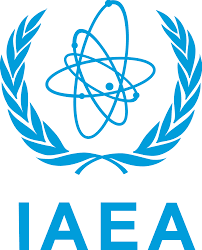
Why in News?
The United Nations atomic watchdog warned of a potential threat to nuclear safety due to a spike in fighting near Europe’s largest nuclear power plant in Ukraine.
- It is the world's foremost intergovernmental forum for scientific and technical cooperation in the nuclear field.
- It is widely known as the world's "Atoms for Peace and Development" organization within the United Nations family.
- It works for the safe, secure and peaceful uses of nuclear science and technology.
- History: Though established as an autonomous organisation, independently of the United Nations through its own international treaty, the IAEA Statute, the IAEA reports to both the United Nations General Assembly and Security Council.
- Headquarters: Vienna, Austria.
- Functions:
- The Agency works with its Member States and multiple partners worldwide to promote the safe, secure and peaceful use of nuclear technologies.
- It applies nuclear safeguards – consisting of monitoring, inspection, information analysis, and other activities – to verify that nuclear activities remain peaceful and detect and deter their diversion, including to weapons-related purposes.
- In particular, the IAEA implements comprehensive safeguards agreements mandated by the Nuclear Non-Proliferation Treaty (NPT), which serve as a first line of defense against nuclear weapons proliferation.
- IAEA assists its Member States and promotes the exchange of scientific and technical information between them.
- IAEA enhances national, regional, and international capacities to respond to nuclear and radiological incidents, which is essential to minimizing their impact.
What is the Nuclear Non-Proliferation Treaty (NPT)?
- It was an agreement signed in 1968 by several of the major nuclear and non-nuclear powers that pledged their cooperation in stemming the spread of nuclear technology.
- With 191 States parties, it is the most widely adhered to treaty in the field of nuclear non-proliferation, peaceful uses of nuclear energy and nuclear disarmament.
- Under the NPT, non-nuclear-weapon States parties have committed themselves not to manufacture or otherwise acquire nuclear weapons or other nuclear explosive devices while nuclear-weapon States parties have committed not to in any way assist, encourage or induce any non-nuclear-weapon State party to manufacture or otherwise acquire nuclear weapons or other nuclear explosive devices.
- Nuclear-weapon States parties under the Treaty are defined as those that manufactured and exploded a nuclear weapon or other nuclear explosive device before 1 January 1967.
- There are five nuclear-weapon States parties to the Treaty.
- Only Israel, India, and Pakistan have never been signatories of the Treaty, and North Korea withdrew from the Treaty in 2003.
Source: The Hindu
One Sun, One World, One Grid (OSOWOG) Initiative
Subject: Environment
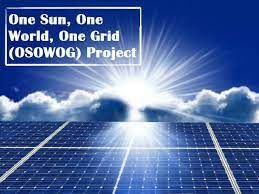
Why in News?
In the run-up to the 18th G20 Summit, a day-long conference on "Transnational Grid Interconnections for One Sun, One World, One Grid (OSOWOG)" was held in New Delhi, on 6th September, 2023. The conference was organized by Power Grid Corporation of India Limited (POWERGRID), a ‘Maharatna’ company under Ministry of Power, Govt. of India.
About One Sun, One World, One Grid (OSOWOG) Initiative:
- The idea for the OSOWOG initiative was put forth by the Prime Minister of India, at the First Assembly of the International Solar Alliance (ISA) in October 2018.
- The initiative aims at connecting energy supply across borders.
- Vision: It aims to connect different regional grids through a common grid that will be used to transfer renewable energy power and, thus, realize the potential of renewable energy sources, especially solar energy.
- The project is being spearheaded by the governments of India and the UK in partnership with the International Solar Alliance (ISA) and the World Bank Group.
- It will bring together a global coalition of national governments, international financial and technical organisations, legislators, power system operators and knowledge leaders to accelerate the construction of the of the new infrastructure needed for a world powered by clean energy.
- When will it be completed? The grid is expected to be set up over the next few years by the ISA. Once operational, it will transport solar power to different countries.
What is International Solar Alliance (ISA)?
- The ISA is an intergovernmental organization that was launched in 2015, by the Prime Minister of India and the President of France, at the United Nations Climate Change Conference held in Paris.
- ISA is an action-oriented, member-driven, collaborative platform for increased deployment of solar energy technologies.
- The ISA is guided by its ‘Towards 1000’ strategy, which aims:
- To mobilize USD 1000 billion of investments in solar energy solutions by 2030;
- To deliver energy access to 1000 million people using clean energy solutions;
- To install 1000 GW of solar energy capacity;
- To mitigate global solar emissions to the tune of 1000 million tonnes of CO2 every year;
- Vision: Let us together make the sun brighter.
- Mission: Every home, no matter how far away, will have a light at home.
- Headquarter: National Institute of Solar Energy (NISE) in Gurugram, India.
Source: PIB
What is the Sovereign Gold Bond (SGB) Scheme?
Subject: Economics
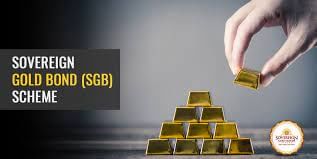
Why in News?
The Reserve Bank of India (RBI) announced on Friday, September 8, the issue price for the upcoming Sovereign Gold Bond (SGB) Tranche 2, scheduled to open for subscription on Monday, September 11, 2023.
- SGBs were introduced by the Government of India in 2015 under the Gold Monetization Scheme.
- SGBs are government securities issued by the RBI on behalf of the Government of India.
- They are substitutes for holding physical gold.
- Features:
- SGBs are denominated in grams of gold with a basic unit of 1 gram.
- Investors have to pay the issue price in cash, and the bonds will be redeemed in cash on maturity.
- Eligible Subscribers: The Bonds will be restricted for sale to resident Indian entities, including individuals (in his capacity as an individual, or on behalf of minor child, or jointly with any other individual), HUFs, Trusts, Universities and Charitable Institutions.
- Tenor: The tenor of the Bond will be for a period of 8 years with an exit option in 5th, 6th and 7th year, to be exercised on the interest payment dates.
- Investment Limit:
- Minimum: 1 gram of gold.
- Maximum: 4 KG for individuals, 4 Kg for HUF and 20 Kg for trusts.
- Interest: 2.5% per annum, paid on a half-yearly basis.
- The interest on Gold Bonds shall be taxable as per the provisions of the Income Tax Act, 1961.
- SGBs can be used as collateral for loans.
Source: The Hindu
Picoflare jets
Subject: Science and Technology
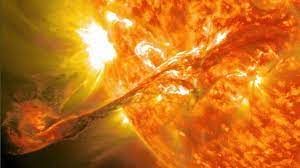
Why in News?
Researchers studying the findings of the Solar Orbiter Aircraft, a joint mission by the European Space Agency and the U.S. space agency NASA, recently announced that they have detected small jets of charged particles intermittently expelled from the sun’s outer atmosphere, at supersonic speeds for 20-100 seconds. These are called picoflare jets.
About Picoflare jets:
- These small-scale picoflare jets were observed within emissions from the coronal hole under observation.
- They lasted only a few dozen seconds, scientists calculated that they provide enough energy to supply a considerable fraction of solar winds.
- Pico” is an order of magnitude that denotes 10-12, or one trillionth of a unit.
- These jets from the sun are named so because they carry approximately one-trillionth the energy of the largest flares the sun is capable of producing,
- Significance:The discovery is important because strong gusts of solar winds, while creating beautiful auroras in polar areas, are capable of disrupting the earth’s magnetic field as well as damaging electronics in satellites in space and in circuits on the ground.
- It is the most complex scientific laboratory ever to have been sent to the Sun.
- It will take images of the Sun from closer than any spacecraft before.
- It contains six remote-sensing instruments and four sets of in situ instruments.
- Objectives
- To observe the Sun’s 11-year cycle of rising and subsiding magnetic activity.
- To study the upper layer of its atmosphere, the corona.
- It was launched in 2020.
Source: The Hindu
|
63 videos|5408 docs|1146 tests
|
















